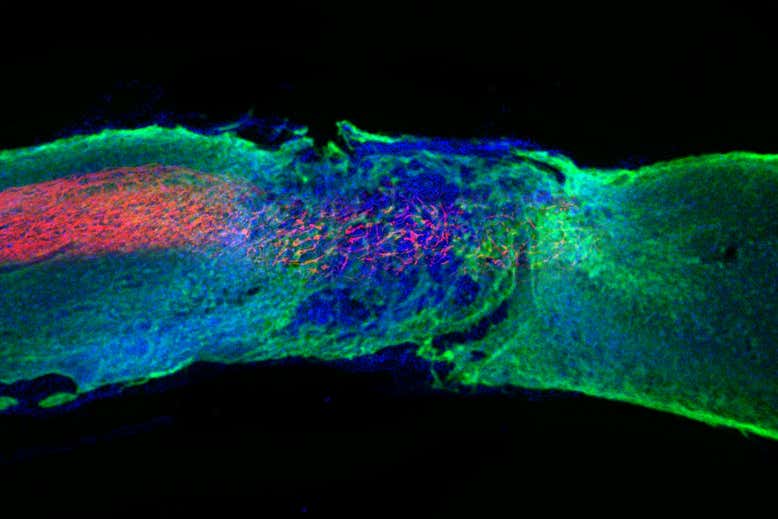A team of US scientists has developed a gel drug that promotes cell regeneration and reverses paralysis in mice with spinal cord injuries, allowing them to walk again within four weeks of treatment.
The new, encouraging study has just been published in the journal Science. The team at Northwestern University is working hard to obtain permission from the FDA and carry out human testing as early as next year.
The aim of our research was to develop translatable therapy that could be brought to the clinic to prevent people from becoming paralyzed after severe trauma or illness.
Samuel Stupp, Northwestern University, the researcher who led the study.

A long-standing goal
Treating paralysis is a goal pursued by medicine for a long time: several cutting-edge research includes experimental treatments using stem cells to create new neurons (nerve cells), gene therapies that “tell” the body to produce certain proteins that help repair nerves, direct injection of proteins or particular plants.
How the new gel was obtained to repair spinal cord injuries
<strong>The Eurobursar</strong> Samuel Stupp used nanofibers to mimic the architecture of the extracellular matrix, a natural network of molecules surrounding tissue responsible for supporting cells. Each fiber is approximately 10.000 times thinner than a human hair and is made up of hundreds of thousands of bioactive molecules called peptides. The peptides then transmit signals to promote nerve regeneration.
The therapy was injected in a gel formulation into the tissue surrounding the spinal cord after an incision in laboratory mice. The researchers decided to wait 24 hours before applying it, because humans who suffer devastating injuries from car accidents, shootings and so on also experience delays in receiving the treatment. The hope is that injecting this type of organic polymer will be able to relieve pain without creating addiction or toxicity and offering long-term stability that could help in chronic conditions.
Four weeks later, the mice that received the treatment regained the ability to walk almost as they did before the injury. The untreated ones didn't.
A subsequent analysis on mice also found significant improvements in the spinal cord at the cellular level as well. Severed extensions of neurons called axons regenerated, and scar tissue (which can act as a barrier to regeneration) was significantly reduced. Even the layer of axons we call myelin, which is important for the transmission of electrical signals, has reformed.
“Dancing” molecules
A key discovery the team made in making this gel was that a certain mutation in the molecules intensified their collective movement and increased their effectiveness. The receptors in neurons are naturally in motion, the researchers explain, so increasing their movement helps them connect more effectively.
The researchers tested two versions of the gel (one with the mutation and one without). Mice that received the modified version regained more functionality.
The gel developed by the scientists is the first of its kind, but it could usher in a new generation of drugs known as “supramolecular drugs”, because therapy is an assembly of many molecules rather than a single molecule.
The next steps for the “supramolecular” gel
According to the team, the gel is safe because the materials biodegrade within a few weeks and become nutrients for cells. The research team now hopes to move quickly to human studies without the need for further testing on animals, such as on primates.

It would be a big blow: according to official statistics, about 75.000 people with spinal cord injuries live in Italy (more than 300.000 in the US). Their life expectancy is shorter, and this hasn't improved in 40 years.
I hope that the health authorities carefully and accurately consider these entirely new therapies that could totally change the fate of this condition.


